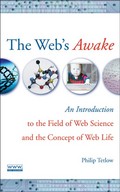The Web's Awake
An Introduction to the Field of Web Science and the Concept of Web Life

1. Auflage Mai 2007
264 Seiten, Hardcover
Wiley & Sons Ltd
Kurzbeschreibung
The central thesis of The Web's Awake is that the phenomenal growth and complexity of the Web is beginning to outstrip our capability to control it directly. Many have worked on the concept of emergent properties within highly complex systems, concentrating heavily on the underlying mechanics concerned. Few, however, have studied the fundamentals involved from a sociotechnical perspective. In short, the virtual anatomy of the Web remains relatively uninvestigated. The Web's Awake attempts to seriously explore this gap, citing a number of provocative, yet objective, similarities from studies relating to both real world and digital systems. It presents a collage of interlinked facts, assertions, and coincidences, which boldly point to a Web with powerful potential for life.
A fascinating perspective on what the Web is and what it will be
Has the World Wide Web evolved into a new life form? The author of this provocative book, Philip Tetlow, presents a very compelling argument that it indeed has.
Drawing from theories originating in the natural sciences, mathematics, and information technology, The Web's Awake explores how the continued growth and increasing complexity of the Web are quickly outstripping our capability to control it. In other words, the Web has quite literally taken on a life of its own.
Stringently researched and clearly presented, the book examines a number of emergent characteristics and behaviors of the Web that have not been programmed, but rather have evolved. As the number and strength of these new Web characteristics and behaviors continue to increase, the author persuasively argues that the Web should be considered a living organism in its own right, a new post-human species consisting of a single member.
Having established a new understanding of what the Web is, the author next offers a remarkable perspective on how the Web is evolving towards independence. He further argues that understanding the Web's evolution as an act of nature enables us to better harness the Web's resources for the good of society.
While researchers in the emerging field of Web science have attempted to categorize what the Web is, this book takes a radically new approach that will change your understanding of the very nature and essence of the Web--what it is and where it is heading. Whether your interest lies in computing, information technology, evolution, physics, or biology, the author's clearly written, plain-English arguments are fascinating material for thought.
Preface.
Acknowledgments.
Prologue.
CHAPTER 1 THE WEB AND LIFE.
CHAPTER 2 THE SPECTRUM OF COMPLEXITY.
CHAPTER 3 THE IMPORTANCE OF DISCRETENESS AND SYMMETRY IN SYSTEMS.
CHAPTER 4 NATURAL STRUCTURES FOR MAN-MADE MACHINES-- CURVATURE IN INFORMATION AND COMPUTATION.
CHAPTER 5 POSITIONAL INFORMATION AND SCALE-FREE NETWORKS.
CHAPTER 6 EVOLUTION THROUGH ENGINEERING.
CHAPTER 7 A LESS-THAN-SIMPLE MATTER OF BOUNDLESS ORGANICS.
CHAPTER 8 EMERGENT INTELLIGENCE AND POSTHUMAN CONCEPTS.
CHAPTER 9 THE PHYSICS OF INFORMATION AND COMPUTING.
CHAPTER 10 COUNTER ARGUMENTS.
APPENDIX A AN OUTLINE OF THE SEMANTIC WEB AND ITS POTENTIAL FOR SOFTWARE ENGINEERING.
APPENDIX B BEYOND THE SEMANTIC WEB.
References.
Index.
About the Author.
"...a surprisingly easy and engaging book to read...an essential book for anyone interested in artificial life, artificial intelligence and information studies." (CHOICE, October 2007)
"...a compelling and enjoyable read, enthralling and thought-provoking...a fascinating and provocative perspective on what the Web is and what it will be." (SirReadaLot.org, June 2007)


